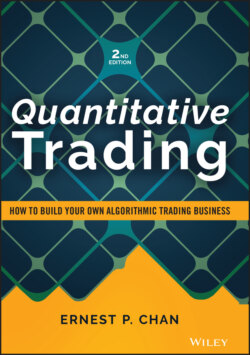Читать книгу Quantitative Trading - Ernest P. Chan - Страница 22
Your Goal
ОглавлениеMost people who choose to become traders want to earn a steady (hopefully increasing) monthly, or at least quarterly, income. But you may be independently wealthy, and long-term capital gain is all that matters to you. The strategies to pursue for short-term income versus long-term capital gain are distinguished mainly by their holding periods. Obviously, if you hold a stock for an average of one year, you won't be generating much monthly income (unless you started trading a while ago and have launched a new subportfolio every month, which you proceed to hold for a year—that is, you stagger your portfolios.) More subtly, even if your strategy holds a stock only for a month on average, your month-to-month profit fluctuation is likely to be fairly large (unless you hold hundreds of different stocks in your portfolio, which can be a result of staggering your portfolios), and therefore you cannot count on generating income on a monthly basis. This relationship between holding period (or, conversely, the trading frequency) and consistency of returns (that is, the Sharpe ratio or, conversely, the drawdown) will be discussed further in the following section. The upshot here is that the more regularly you want to realize profits and generate income, the shorter your holding period should be.
There is a misconception aired by some investment advisers, though, that if your goal is to achieve maximum long-term capital growth, then the best strategy is a buy-and-hold one. This notion has been shown to be mathematically false. In reality, maximum long-term growth is achieved by finding a strategy with the maximum Sharpe ratio (defined in the next section), provided that you have access to sufficiently high leverage. Therefore, comparing a short-term strategy with a very short holding period, small annual return, but very high Sharpe ratio, to a long-term strategy with a long holding period, high annual return, but lower Sharpe ratio, it is still preferable to choose the short-term strategy even if your goal is long-term growth, barring tax considerations and the limitation on your margin borrowing (more on this surprising fact later in Chapter 6 on money and risk management).
